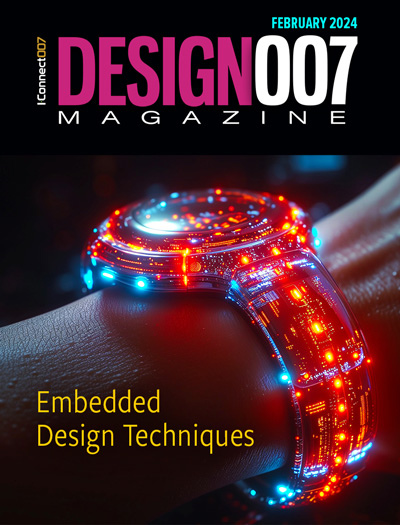-

- News
- Books
Featured Books
- design007 Magazine
Latest Issues
Current Issue
Level Up Your Design Skills
This month, our contributors discuss the PCB design classes available at IPC APEX EXPO 2024. As they explain, these courses cover everything from the basics of design through avoiding over-constraining high-speed boards, and so much more!

Opportunities and Challenges
In this issue, our expert contributors discuss the many opportunities and challenges in the PCB design community, and what can be done to grow the numbers of PCB designers—and design instructors.

Embedded Design Techniques
Our expert contributors provide the knowledge this month that designers need to be aware of to make intelligent, educated decisions about embedded design. Many design and manufacturing hurdles can trip up designers who are new to this technology.
- Articles
- Columns
Search Console
- Links
- Events
||| MENU - design007 Magazine
An Experienced Millennial on Hiring the Next Generation
April 24, 2019 | Andy Shaughnessy, Design007 MagazineEstimated reading time: 2 minutes
During DesignCon, I met with Geoffrey Hazelett, VP of sales for Polar Instruments. Even though he has been in EDA for a few years, Geoffrey is still in his thirties, which makes him a youthful cherub in this industry. I asked Geoffrey what he thinks about the new PCB designers and EEs entering this field, and what more can be done to expose young people to the world of PCBs.
Andy Shaughnessy: We’re finally starting to see more young people in this industry. Even though you joke about being on the “grizzled upper-end of millennials,” you are younger than 50 and have all of your hair.
Geoffrey Hazelett: And I intend to keep my hair, so thank you.
Shaughnessy: What are your thoughts on young people entering the industry? When you were in college, was there any knowledge that this was something you could do for a career?
Hazelett: I recall asking my professors about this, and they told me, “Don’t worry about PCB design. Somebody else will do that for you. You’re going to do VLSI or ASIC design.” I think what has changed is people with master’s degrees and Ph.D.s in electrical engineering look at this and say, “This is how we’re going to have to do PCB design.” Now, it requires training on the education side that didn’t formally exist even 20 years ago. And now some universities—only a few—have signal and power integrity programs.
How are we going to pass on the information, knowledge, and experience from those people who fought the battles to develop this technology to the new designers coming into the industry? There are good resources out there—such as programs, training classes, and workshops at shows like this—but you have to be able to get your company to send you to a conference like DesignCon.
When I first joined, part of my hiring process with Polar Instruments was sending me to one of Eric Bogatin’s last public signal and power integrity classes. Polar Instruments’ President Ken Taylor said, “Think about the offer, but either way, we want you to go to this because it’s the last one that he’s doing publicly.” Now, Eric teaches at University of Colorado and has an online academy.
Shaughnessy: Growing up, you must have had video games.
Hazelett: I remember before the internet was ubiquitous, the first computer I ever touched and played with was a 486—maybe an early Apple product. It wasn’t until high school that I started seeing people with cellphones. Now, I have friends who have kids who are six years old and monitor their screen time.
To read this entire interview, which appeared in the March 2019 issue of Design007 Magazine, click here.
Suggested Items
SMC Korea 2024 to Highlight Semiconductor Materials Trends and Innovations on Industry’s Path to $1 Trillion
04/24/2024 | SEMIWith Korea a major consumer of semiconductor materials and advanced materials a key driver of innovation on the industry’s path to $1 trillion, industry leaders and experts will gather at SMC (Strategic Materials Conference) Korea 2024 on May 29 at the Suwon Convention Center in Gyeonggi-do, South Korea to provide insights into the latest materials developments and trends. Registration is open.
Elevating PCB Design Engineering With IPC Programs
04/24/2024 | Cory Blaylock, IPCIn a monumental stride for the electronics manufacturing industry, IPC has successfully championed the recognition of the PCB Design Engineer as an official occupation by the U.S. Department of Labor (DOL). This pivotal achievement not only underscores the critical role of PCB design engineers within the technology landscape, but also marks the beginning of a transformative journey toward nurturing a robust, skilled workforce ready to propel our industry into the future.
Real Time with... IPC APEX EXPO 2024: Going Vertical: SCHMID's Advanced Solutions for Printed Circuit Boards
04/24/2024 | Real Time with...IPC APEX EXPOEditor Marcy LaRont chats with Bob Ferguson, the president of SCHMID, about advanced solutions for PCBs and the equipment they are highlighting at this year's show. He delves into vertical no-touch handling systems and the prospect of achieving sub-10-micron lines. Inspired by SCHMID's technology, Bob expresses excitement about where the industry is today.
Big Win for Defense Production Act Budget Allocation in FY24 Budget
04/23/2024 | I-Connect007 Editorial TeamOne year ago, President Biden issued a determination that chips and packaging are critical for national security. Since that time, much work has been done to continue the conversation in Washington, elevating the importance of the entire chips value chain, and including printed circuit boards and substrates, without which chips cannot operate.
Zentech’s Board of Directors Announces the Return of Matt Turpin as President and CEO
04/22/2024 | Zentech ManufacturingTurpin draws upon over 35 years of experience in the electronics industry and has an 18-year history with Zentech. He previously served as President and CEO from 2006 to 2019 after which time he has remained active in the EMS industry as an advisor to Zentech and other industry organizations.


